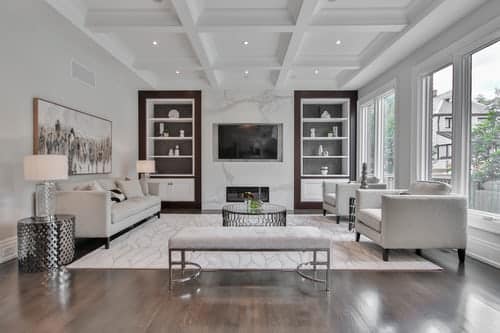As we move further into the 21st century, the relationship between our built environment and the natural world becomes increasingly relevant. This balance is nowhere more critical than in our urban landscapes, where the denseness of human-made structures can leave us feeling disconnected from the natural world. This is where biophilic design comes in. Biophilic design incorporates elements of nature into the built environment, creating green spaces that aren’t just aesthetically pleasing, but also contribute to human health and well-being.
What is Biophilic Design?
At the heart of this discussion is an understanding of what biophilic design is. Coined by the biologist Edward O. Wilson, the term ‘biophilia’ refers to the ‘love of life and the living world.’ In essence, biophilic design fuses the built and natural environments, integrating nature into our living and working spaces, in urban environments.
A voir aussi : What Are the Critical Considerations for Real Estate Investment in UK’s Post-Industrial Cities?
Biophilic design is not simply about adding plants to your workspace or home. It’s much more profound and comprehensive. It encompasses elements such as natural light, views of nature, natural materials, and direct and indirect experiences of nature. The aim is to create a continuity between indoor environments and the outside world, fostering a sense of well-being and offering numerous health benefits.
The Health Benefits of Biophilic Design
The importance of integrating nature into our built environment goes beyond aesthetics. Numerous studies have shown that biophilic design can have a profound impact on our overall health and well-being.
En parallèle : How Can Real Estate Developers Create Mixed-Use Spaces That Drive Local Economic Growth?
Biophilic elements such as plants and natural light can reduce stress, improve cognitive function, and enhance mood and creativity. A study published in the Journal of Environmental Psychology found that workers in offices with natural elements reported a 15% higher level of well-being, a 6% higher level of productivity, and a 15% higher level of creativity compared to those in environments devoid of nature.
Additionally, biophilic design can also improve air quality, reduce noise levels, and regulate temperature, contributing to a healthier indoor environment. Not to mention, green spaces and natural features can encourage physical activity, thereby promoting physical health.
Energy Efficiency and Sustainability: The Green Benefits of Biophilic Design
Beyond the direct benefits to human health and well-being, biophilic design also plays a crucial role in promoting energy efficiency and sustainability in our urban landscapes.
Energy efficiency is one of the cornerstones of biophilic design. By using natural light, for instance, we can significantly reduce our dependence on artificial lighting, leading to a dramatic decrease in energy consumption. Similarly, by incorporating green roofs and walls into urban buildings, we can reduce the urban heat island effect, minimizing the need for air conditioning in warm weather.
In terms of sustainability, biophilic design encourages the use of local and sustainable materials, reducing the built environment’s carbon footprint. Green spaces also play a critical role in absorbing carbon dioxide, mitigating the effects of climate change.
Implementing Biophilic Design in Real Estate Projects
Now that we’ve established the benefits of biophilic design, let’s explore how we can practically implement it in urban real estate projects.
Biophilic design starts at the planning stage. In urban environments, this could mean prioritizing green spaces in and around buildings. This could take the form of green roofs, gardens, courtyards, or balconies. Green walls, both exterior and interior, are another effective way to incorporate nature into urban spaces.
Natural light is another key element of biophilic design. This means designing buildings with large windows, skylights, and open spaces that allow for maximum natural light penetration.
The use of natural materials is also a key aspect of biophilic design. This could mean using wood, stone, and other natural elements in building design. It’s not just about appearance; these materials also provide tactile and olfactory experiences that can enhance our connection to the natural world.
Case Study: Biophilic Design in Action
To better understand the impact of biophilic design, let’s look at a real-world example. The Bullitt Center in Seattle, USA, often referred to as the ‘greenest commercial building in the world,’ is an excellent example of biophilic design in practice.
The building features a variety of biophilic elements, such as a green roof, a living wall, and large windows that allow for maximum natural light. The building is also fitted with energy-efficient systems, including a rainwater collection system and a geothermal energy system.
The Bullitt Center is proof that biophilic design is not just a luxury or a trend; it’s a viable and beneficial way to build our urban environments. It’s a testament to the fact that when we design with nature in mind, the results are not only beautiful but also contribute to our health, well-being, and the sustainability of our planet.
The Role of Technology in Biophilic Design
Technology plays a significant role in advancing biophilic design by providing innovative methods and tools to incorporate nature into the built environment. From architectural software that integrates design principles based on biophilic design, to advanced materials and construction techniques that mimic natural patterns, technology is instrumental in bringing the power of nature into our urban spaces.
One of the key technological advancements in this area is the use of virtual and augmented reality. These technologies can simulate natural environments, providing direct and indirect experiences of nature, even in the most densely populated urban environments.
Computer modelling and simulation tools are also widely used to optimize the use of natural light in buildings. These tools allow designers to precisely calculate how sunlight will interact with a building at different times of the day and year, ensuring maximum natural light penetration.
Another major technological contribution to biophilic design is the development of advanced materials that mimic natural elements. From biomimetic materials that emulate the properties of natural materials, to living building materials that can grow and adapt like living organisms, these innovations bring a new dimension to our connection to nature in the built environment.
On the research side, online platforms like Google Scholar and Crossref provide access to a vast body of research on biophilic design. This research is invaluable in informing design decisions and proving the health and well-being benefits of biophilic design.
Conclusion: The Future of Urban Real Estate is Biophilic
As we continue to grapple with the challenges of urbanization, climate change, and public health, the importance of biophilic design in urban real estate cannot be overstated. Incorporating natural elements into our built environment enhances the quality of life, fosters health and well-being, and contributes to the sustainability of our cities.
Biophilic design represents an important shift in the way we think about and interact with our built environment. It allows us to create spaces that not only look good but also do good, benefitting both individuals and the wider community.
The growing body of research on the benefits of biophilic design, coupled with advances in technology and design practices, has made it increasingly attainable and affordable. For developers and architects, adopting biophilic design principles represents a win-win scenario, delivering projects that are attractive, sustainable, and conducive to human health.
Biophilic design is not just a trend; it’s the future of urban real estate. As we continue to understand and appreciate the profound impact of our natural environment on our health and well-being, it’s clear that a connection to nature is not a luxury, but a necessity. As such, biophilic design is poised to become a standard feature in urban real estate projects, helping to create healthier, happier, and more sustainable cities for future generations.











